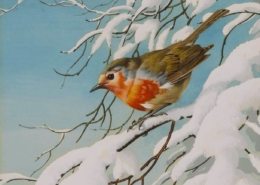
About the artist
The artistic journey of Basil Ede began early; after completing school, he studied at the Kingston School of Art in Surrey, though mandatory military service temporarily halted his professional progress. Following his discharge from the army in 1951, he took a position as a purser in the Merchant Navy, which allowed him to travel extensively in the Far East. The regional art he experienced during these travels profoundly influenced his evolving style. Later, when he became an executive at the Cunard line, he began selling his bird illustrations to the company, which were subsequently used for their first-class menu cards.
By the late 1950s, Ede was frequently exhibiting his work in London, including two successful shows hosted by The Tryon Gallery. His reputation expanded internationally in 1964 when his art was featured in the first-ever solo exhibition given to a living artist by the Smithsonian in Washington D.C. (at the time known as the National Collection of Fine Arts).
A major life change occurred in 1989 when Ede suffered a stroke, which resulted in the paralysis of his right arm. Determined to continue his work, he successfully retrained himself to paint using his left hand. During this difficult transition, his preferred medium changed from watercolour to oils. He favoured oils because they offered a greater time window for adding meticulous detail and allowed for bolder colours and a more expressive technique.
Ede was deeply involved in conservation efforts, serving as a founder member of the Society of Wildlife Artists. He also acted as an honorary trustee for Ducks Unlimited, a U.S. organization dedicated to wildfowl and wetland conservation, and was a lifetime supporter and member of the Royal Society for the Protection of Birds. His significant career contributions were formally recognized in 1992 with a Lifetime Achievement Award from the South-eastern Wildlife Exposition in Charleston, South Car
Available Artwork




